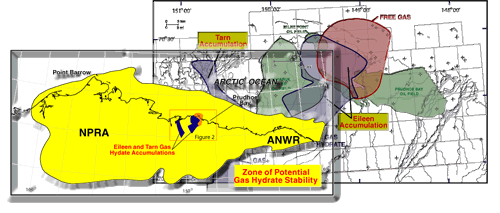Drilling is complete on an Alaskan North Slope well, cofunded by the Department of Energy, that could prove to be an important milestone in assessing America's largest potential fossil energy resource: gas hydrate.
Gas hydrate is an ice-like solid that results from the trapping of methane molecules - the main component of natural gas - within a lattice-like cage of water molecules. Dubbed the "ice that burns," this substance releases gaseous methane when it melts.
The size of the global gas hydrate resource is staggering, holding more ultimate energy potential than all other fossil fuels combined, according to the U.S. Geological Survey (USGS). In the United States, where gas hydrate occurs beneath the permafrost of Alaska's arctic north and below the seabed offshore, the volume of this resource is massive. USGS estimates that the Nation's gas hydrate deposits contain 200,000 trillion cubic feet (Tcf) of natural gas. Compare this with a known recoverable natural gas resource of approximately 1,500 Tcf. If just one percent of the gas hydrate resource could be rendered producible, our Nation's natural gas resource base would more than double.

The "Mt. Elbert Prospect" well was drilled from an ice pad, constructed to protect the sensitive arctic tundra. The well is designed to verify the nature of one of 12 gas hydrate accumulations previously identified by the project within the Milne Point unit of the greater Prudhoe Bay region of Alaska's North Slope.
The project is a joint effort of the Office of Fossil Energy's National Energy Technology Laboratory (NETL), the USGS, BP Exploration Alaska, the Alaska native-owned Arctic Slope Regional Corporation, the Universities of Arizona and Alaska (Fairbanks), and others.
A team of scientists from these and other organizations will be on the well site to collect and evaluate core samples, geophysical well logs, and other data designed to help determine the potential natural gas production from hydrate zones and possibly lead to more extensive production tests on the North Slope.
The project is being conducted through the National Methane Hydrate R&D Program, a DOE-led collaboration of seven federal agencies with a broad mandate to improve our understanding of gas hydrate's role in the natural environment and potential as a future source of natural gas.
Written from a news release issued by National Energy Technology Laboratory.




Comments